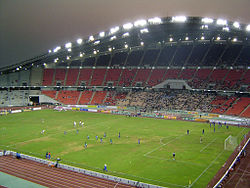Rajamangala Stadium: Difference between revisions
m clean up, Replaced: eliptic → elliptic,, typos fixed: frustation → frustration, exagerrated → exaggerated, competitons → competitions using AWB |
No edit summary |
||
| Line 22: | Line 22: | ||
The aforementioned side tribunes are designated 'East' and 'West'. 'East' is the uncovered popular side; 'West' is the covered side where the more expensive seats are. The two ends are designated 'North' and 'South'. 'North' is the more popular of the two. It's where the more vocal amd colourful elements of the Thai support congregate. |
The aforementioned side tribunes are designated 'East' and 'West'. 'East' is the uncovered popular side; 'West' is the covered side where the more expensive seats are. The two ends are designated 'North' and 'South'. 'North' is the more popular of the two. It's where the more vocal amd colourful elements of the Thai support congregate. |
||
The capacity of the stadium is difficult to ascertain. The oft-quoted figure of 65,000 was the capacity when the stadium first opened but at that time the 'North', 'South' and 'East' sides were bare, concrete steps. The stadium has been equipped with proper seats since since. This work must have pushed the capacity down. The capacity has been estimated thus at 55,000. |
The capacity of the stadium is difficult to ascertain. The oft-quoted figure of 65,000 was the capacity when the stadium first opened but at that time the 'North', 'South' and 'East' sides were bare, concrete steps. The stadium has been equipped with proper seats since since. This work must have pushed the capacity down. The capacity has been estimated thus at 55,000 according to www.stadiumzone.net. |
||
The stadium is not served by public transport which has always been a source of frustration for fans. No [[Bangkok Skytrain]]s, subway-trains or normal overground trains stop anywhere near the stadium (unlike at the [[Suphachalasai Stadium]], which is served by the Skytrain - [[National Stadium Station]]). However, there are buses and taxis which pass fairly close to the stadium. |
The football and athletics stadium is not served by public transport which has always been a source of frustration for fans. No [[Bangkok Skytrain]]s, subway-trains or normal overground trains stop anywhere near the stadium (unlike at the [[Suphachalasai Stadium]], which is served by the Skytrain - [[National Stadium Station]]). However, there are buses and taxis which pass fairly close to the stadium. |
||
[[Image:Rajamangala Stadium.jpg|left||thumb|Rajamangala National Stadium]] |
[[Image:Rajamangala Stadium.jpg|left||thumb|Rajamangala National Stadium]] |
||
Revision as of 09:02, 12 August 2009
 | |
 | |
| Location | Bangkok, Thailand |
|---|---|
| Owner | Sports Authority of Thailand (SAT) |
| Capacity | circa 55,000 |
| Surface | Grass |
| Construction | |
| Opened | 1998 |
| Architect | Faculty of Architecture, Chulalongkorn University |
| Tenants | |
1998 Asian Games 2007 Summer Universiade 2000 Thailand National Games | |
Rajamangala National Stadium (Also known as Hua Mark Indoor Stadium) in Hua Mak, Bang Kapi, Bangkok is the national stadium of Thailand. It opened in 1998 and it is the home stadium for the Thailand national football team.
It was first used for the 1998 Asian Games in 1998. Since then, it has been used for many international matches and football tournaments. Most notably, for the 2007 AFC Asian Cup. Thai club sides have also used the stadium when playing in continental cup competitions. Krung Thai Bank FC (now Bangkok Glass FC) used it for AFC Champions League matches, and PEA FC and Chonburi FC have recently used it in the AFC Cup. Aside from football, it has been used for athletics, pop concerts and political rallies.
It was designed by the Faculty of Architecture at Chulalongkorn University. The main material used in construction was concrete and therefore, though the stadium is impressive and imposing, it could never be described as beautiful. However, it is undoubtedly dramatic. The stands rise and fall like a giant, exaggerated version of Huddersfield's Galpharm Stadium. At each end are quite narrow tiers of seats but the tiers rise and rise as they move round the sides until they peak level with the half-way line. From an aesthetic point-of-view, the stadium is best viewed from a distance, preferably from the air, where the elliptical shape of the side tribunes seems partculalrly pronounced.
The aforementioned side tribunes are designated 'East' and 'West'. 'East' is the uncovered popular side; 'West' is the covered side where the more expensive seats are. The two ends are designated 'North' and 'South'. 'North' is the more popular of the two. It's where the more vocal amd colourful elements of the Thai support congregate.
The capacity of the stadium is difficult to ascertain. The oft-quoted figure of 65,000 was the capacity when the stadium first opened but at that time the 'North', 'South' and 'East' sides were bare, concrete steps. The stadium has been equipped with proper seats since since. This work must have pushed the capacity down. The capacity has been estimated thus at 55,000 according to www.stadiumzone.net.
The football and athletics stadium is not served by public transport which has always been a source of frustration for fans. No Bangkok Skytrains, subway-trains or normal overground trains stop anywhere near the stadium (unlike at the Suphachalasai Stadium, which is served by the Skytrain - National Stadium Station). However, there are buses and taxis which pass fairly close to the stadium.

